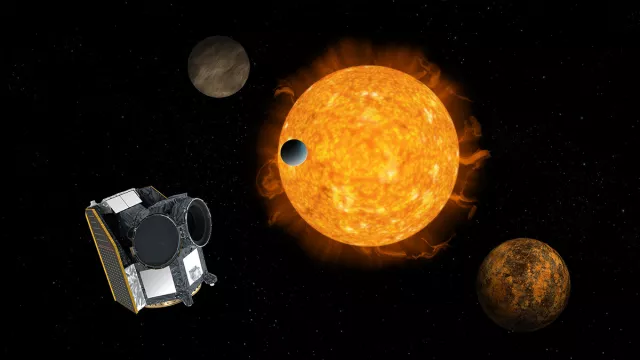Built by ESA in partnership with a scientific consortium led by Switzerland, CHEOPS is a space telescope designed to observe exoplanets close up.
Key information
| Mission | Explore known exoplanets in detail |
|---|---|
| Domain | Science |
| Launch date | 18 December 2019 |
| Partners | ESA and numerous European countries (Austria, Belgium, Germany, Hungary, Italy, Portugal, Spain, Sweden, Switzerland and United Kingdom) |
| Where | Circular Sun-synchronous orbit (650-800 km) |
| Lifetime | At least 3½ years |
| Status | In operation |
Key figures
- 32-cm-diameter telescope
- 500 to 1,000 stars observed
- 1,600-mm focal length
- 273 kg: satellite mass
Key milestones
- October 2023: Mission extended two years by ESA
- 18 December 2019: CHEOPS launched by Soyuz
- April 2018: Instruments assembled on spacecraft bus in Spain
- December 2017: Scientific instrument assembled in Bern, Switzerland
- 19 February 2014: Mission adopted by ESA
- 19 October 2012: CHEOPS selected by ESA for its Cosmic Vision programme
Project in brief
The European CHEOPS telescope (CHaracterising ExOPlanet Satellite) looks for transits or ‘mini-eclipses’ in the light curves of stars already thought to have planets orbiting around them, caused by the dip in brightness when their planet passes in front of them. Exoplanets thus detected—several of which are super-Earths less than 10 times more massive than our Earth—are then analysed in fine detail to determine their size, mass, density and structure, and to ascertain if they have an atmosphere.
Selected for Europe’s Cosmic Vision 2015-2025 programme, the CHEOPS mission was proposed and is being led by a team of scientists at the University of Bern. It takes its inspiration from the European CoRoT mission for which CNES was prime contractor, using the same transit detection method and measuring techniques. Methods for processing raw data on the ground from the light curves ‘cleaned’ of noise and bias are supplied by the LAM astrophysics laboratory in Marseille, like for CoRoT, with support from CNES.
CHEOPS is expected to observe between 500 and 1,000 nearby stars during its planned 3½-year mission.
CNES’s role
CHEOPS succeeded CNES’s CoRoT mission, from which it draws its inspiration, and the agency is supporting contributing French research laboratories.
Contacts
Exobiology, Exoplanets and Planetary Protection subject matter expert
Christian Mustin
E-mail: christian.mustin at cnes.fr


